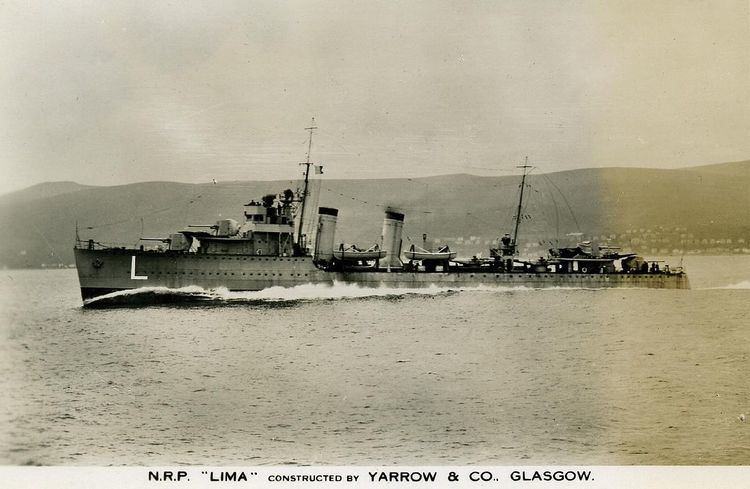Name Douro-class destroyer Preceded by Guadiana class In commission 1933-1967 | ||
 | ||
Builders YarrowLisbon Naval Arsenal | ||
The Douro class of destroyers included five ships used by the Portuguese Navy (Marinha Portuguesa) between 1933 and 1967 and two used by the Colombian Navy (Armada de la Repúbica de Colombia).
Contents
It is to note, that, in Portugal, this class of destroyers is usually referred to as the Vouga class, with the term Douro class being usually employed to designate the previous class of Portuguese destroyers also known as Guadiana class.
Design and construction
In 1930, the Portuguese navy drew up a 10 year shipbuilding programme to replace its aging fleet, with planned purchases including two cruisers, twelve destroyers and a number of submarines and sloops. The competition for the design for destroyers was won by Yarrow Shipbuilders beating bids from Thornycroft and Italian shipyards. An order was placed for four ships on 12 June 1931, with two ships, Vouga and Lima to be built by Yarrows in the UK and the remaining ships, Tejo and Douro to be built at Lisbon with machinery to be supplied by Yarrow. A fifth ship, Dão, again to be built in Lisbon using Yarrow-supplied machinery, was ordered on 18 January 1933.
Yarrow's design was based on Ambuscade, a prototype destroyer built for the Royal Navy in 1926. The ships were 323 feet (98.45 m) long overall and 307 feet (93.57 m) between perpendiculars, with a beam of 31 feet (9.45 m) and a draught of 11 feet (3.35 m). The ship displaced 1,219 long tons (1,239 t) standard and 1,563 long tons (1,588 t) full load. Three Yarrow boilers fitted with air pre-heaters and superheaters supplied steam at 400 pounds per square inch (2,800 kPa) to geared steam turbines, driving two propeller shafts and generating 33,000 shaft horsepower (25,000 kW), giving a speed of 36 knots (67 km/h; 41 mph). Sufficient fuel was carried to give a range of 5,400 nautical miles (10,000 km; 6,200 mi) at 15 knots (28 km/h; 17 mph).
Armament was similar to contemporary Royal Navy destroyers, with a gun armament of four 4.7 in (120 mm) Vickers-Armstrong Mk G guns, and three 40 mm (2-pounder) 'pom-pom' anti-aircraft guns. Two quadruple banks of 21 inch (530 mm) torpedo tubes were carried, while two depth charge throwers and 12 depth charges constituted the ships' anti-submarine armament. Up to 20 mines could be carried. The ships complement was 147 officers and men.
The two Yarrow-built ships were laid down in October 1931, and commissioned in 1933, while the first two Lisbon-built ships, Tejo and Douro, laid down in 1932, were sold to the Colombian Navy before completion in response to the Leticia Incident between Columbia and Peru, and Peru's purchasing of two ex-Russian destroyers (Almirante Guise and Villar) from Estonia. Renamed Antioquia and Caldas, respectively, they served the Colombians as the Antioquia class. Two further ships were ordered by the Portuguese Navy to replace them.
Service
The five destroyers carried out patrols to defend Portugal's neutrality during the Second World War. Their anti-aircraft armament was revised during 1942–43, with the three pom-poms and one of the banks of torpedo tubes replaced by six 20 mm cannon. They were refitted by Yarrow from 1946–49, with the machinery refurbished, anti-aircraft armament again revised to three Bofors 40 mm gun in powered mounts and three 20 mm cannon, and sonar and radar (British Type 285 and Type 291) fitted. Douro reached a speed of 34.05 knots (63.06 km/h; 39.18 mph) at 28,085 shaft horsepower (20,943 kW) during post-refit trials.
Four of the five destroyers were refitted and modernised again in 1957, (Douro was not refitted, and was disposed of in 1959) with two 4.7 inch guns removed, allowing a Squid anti-submarine mortar to be fitted and the anti-aircraft armament to be increased to five 40 mm Bofors guns and three 20 mm cannon. The last of the class, Vouga, was discarded in 1967.
